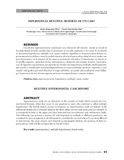Mostrar el registro sencillo del ítem
Hiperdoncia múltiple. Reporte de un caso
| dc.rights.license | http://creativecommons.org/licenses/by-nc-sa/3.0/ve/ | |
| dc.contributor.author | Quevedo, Maira | |
| dc.contributor.author | Fernández Diez, Sarah | es_VE |
| dc.date.accessioned | 2011-10-27T18:47:39Z | |
| dc.date.available | 2011-10-27T18:47:39Z | |
| dc.date.issued | 2011-10-27T18:47:39Z | |
| dc.identifier.issn | 1856-3201 | es_VE |
| dc.identifier.uri | http://www.saber.ula.ve/handle/123456789/33987 | |
| dc.description.abstract | Los dientes supernumerarios constituyen una alteración del número donde se excede la formula dental normal; cuando éstos se presentan en un solo cuadrante o en varios; la condición se denomina hiperdoncia múltiple. Los cuartos molares, segundos en frecuencia para dientes supernumerarios se definen como la unidad dentaria adicional que se ubica distal al tercer molar; son poco frecuentes y en la mayoría de los casos se encuentran retenidos. Comúnmente, se ubican en el maxilar superior, presentan forma rudimentaria y alteración del tamaño dentario (microdoncia). El siguiente caso presenta una paciente de 18 años con hiperdoncia múltiple, multicuadrante, que acudió a consulta por sintomatología dolorosa en zona mandibular posterior izquierda y cuyo estudio radiográfico permitió dilucidar el origen del dolor; arrojando adicionalmente como hallazgo, la presencia de tres dientes supernumerarios correspondientes a cuartos molares. | es_VE |
| dc.language.iso | es | es_VE |
| dc.rights | info:eu-repo/semantics/openAccess | |
| dc.subject | Supernumerarios | es_VE |
| dc.subject | Hiperdoncia múltiple | es_VE |
| dc.subject | Cuarto molar | es_VE |
| dc.title | Hiperdoncia múltiple. Reporte de un caso | es_VE |
| dc.title.alternative | Multiple hyperdontia. Case report | es_VE |
| dc.type | info:eu-repo/semantics/article | |
| dc.description.abstract1 | Supernumerary teeth are an alteration in the number of teeth which exceeds the normal dental formula, when they occur in one quadrant or more, the condition is called multiple hyperdontia. The fourth molars, second in frequency to supernumerary teeth are defined as the additional dental unit it’s located distal to the third molar, are rare and most cases are retained. It is commonly located in the upper jaw, have abnormal size (microdontia) and rudimentary looks. The following case presents a patient 18 with hyperdontia multiple in different quadrants, she consulted for pain symptoms in the left posterior mandibular area and whose X-ray study allowed to determinate the cause of pain, and obtained as radiographic finding the presence of three supernumerary teeth which corresponded to fourth molars. | es_VE |
| dc.description.colacion | 61-66 | es_VE |
| dc.identifier.depositolegal | PP200502ME2052 | es_VE |
| dc.subject.facultad | Facultad de Odontología | es_VE |
| dc.subject.keywords | Supernumerary | es_VE |
| dc.subject.keywords | Multiple hyperdontia | es_VE |
| dc.subject.keywords | Fourth molar | es_VE |
| dc.subject.publicacionelectronica | Revista Odontológica de Los Andes | es_VE |
| dc.subject.seccion | Revista Odontológica de Los Andes: Trabajos de Revisión | es_VE |
| dc.subject.thematiccategory | Medicina y Salud | es_VE |
| dc.subject.tipo | Revistas | es_VE |
| dc.type.media | Texto | es_VE |
Ficheros en el ítem
Este ítem aparece en la(s) siguiente(s) colección(ones)
-
Revista Odontológica de Los Andes - Vol. 006 - Nº 1
enero - junio 2011


